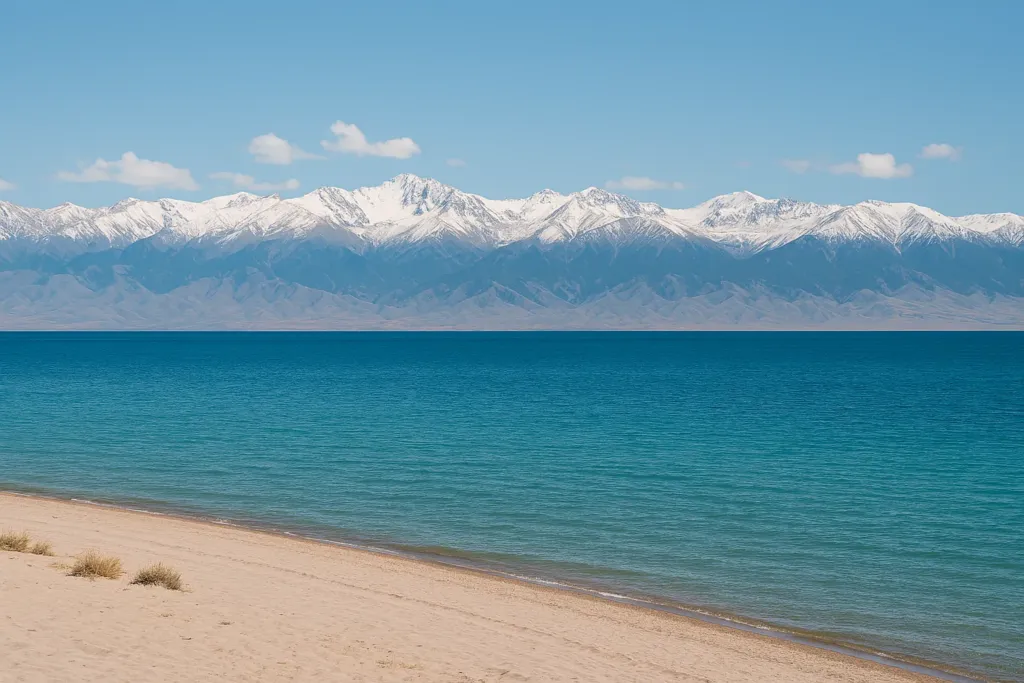Issyk-Kul is the world’s second-largest alpine lake by area after Titicaca, at about 6,236 km². That is roughly the size of the US state of Delaware or about one-third of Montenegro — a striking expanse of water perched high in the Tien Shan. Measuring around 182 km long and up to 60 km wide, it stretches almost like the straight-line distance from London to Edinburgh, framed by snow-capped peaks.
Its maximum depth reaches about 668 m — nearly 0.8 of the Burj Khalifa’s height, or two Eiffel Towers stacked. With an average depth near 278 m and salinity around 0.6 percent — about one-sixth of the ocean — the lake’s central basin rarely freezes. That thermal inertia explains its Kyrgyz name, “warm lake”.
By volume, Issyk-Kul delivers the biggest surprise: roughly 1,738 km³ — more water than North America’s Lake Ontario. Although smaller in area than Titicaca, it holds almost twice the water thanks to its depth. It is one of the largest endorheic saline lakes on Earth, fed by about 118 rivers and streams with no visible outflow — losses occur via evaporation and likely subterranean pathways.
The shoreline runs for about 670 km — a miniature circumnavigation around a mountain sea. The lake’s microclimate brings over 250 sunny days a year and milder winters along the coast versus nearby valleys, which is why Soviet-era resorts flourished here — from sandy north-shore beaches to hot springs and sanatoria.
Its underwater archaeology is uniquely compelling: near Cholpon-Ata and Karakol, archaeologists found remnants of ancient settlements, walls and artifacts up to 2,500 years old. Imagine a “Kyrgyz Atlantis” beneath crystal waters — highland nature fused with deep history.
Ecologically, Issyk-Kul anchors a biosphere reserve and a major flyway stopover. Thousands of waterfowl gather on its ice-free expanse in winter — unusual above 1.6 km elevation. Native fish include endemic osmans and schneiders, while introductions have reshaped the food web — a reminder of how isolated systems respond to change.
Swimming season on the north shore runs longer than the regional norm: shallows warm to 20–24°C in summer while offshore waters stay bracing. Unlike the Dead Sea, buoyancy is modest — but your eyes and skin appreciate the gentle, near-fresh feel.
Adventure sports here come with numbers: day hikes start near 1,700–1,800 m and crest 3,000–4,000 m passes in one or two days — rare altitude gains without long transfers. Channel-style swims and ultramarathons leverage the 60 km width — English Channel distances, but under glaciated summits.
Comparisons underline its uniqueness: by area, Issyk-Kul is about one-fifth of Lake Baikal, yet by depth it beats all but a handful of lakes worldwide. Its surface sits higher than Scotland’s Ben Nevis — you literally swim “above a mountain”. And the trio of high elevation, mild salinity and persistent ice-free conditions makes it virtually one-of-a-kind in Eurasia.
Practical scale matters too: it’s a 4–6 hour drive from Bishkek, yet a full lap is 670 km — better split into two or three days with stops in Cholpon-Ata, Karakol and the wild south shore. Here, raw numbers turn directly into memorable experiences.
- Tonga
- Nicaragua
- Sumatra
- Pura Vida on the Road: the nuances of traveling Costa Rica
- Norway’s Atlantic Road scenic drive
- In the footsteps of Buratino: tourist spots from the beloved fairy tale and film
- 12 of the best places to visit in April in Europe: beaches, Easter, cities, and adventures
- Hiroshima’s nuclear blast: how tragedy reshaped travel routes
- Dance of Spirits in the Arctic Sky: The Northern Lights in Lofoten Island Mythology
- Evacuation of Kyiv icons takes fight for Ukraine’s heritage to Louvre in Paris
- Taco – the taste of Mexico in your hand: history, traditions and travel routes
- From a Scientific Point of View: The Grand Canyon
- Born for battle: the world’s most warlike cultures
- The Driest Places on Earth: A Journey into the Realm of Aridity
- What to know when going to Brazil ?
- Madagaskar
- Aquavit – the Nordic spirit in a glass: history, taste and travel routes
- Greenland
- Bosphorus
- Greece











